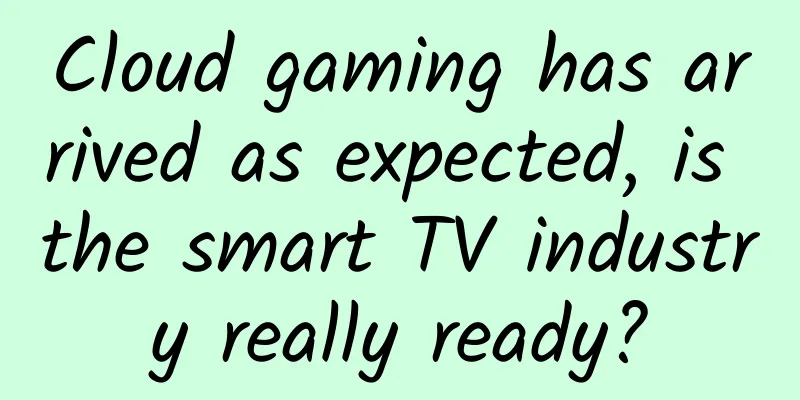Cloud gaming has arrived as expected, is the smart TV industry really ready?

|
It has been 11 years since the concept of cloud gaming was first proposed. This year, with the support of many giants, cloud gaming has finally become a reality, with people from all walks of life welcoming cloud gaming. Among them, smart TV manufacturers are particularly concerned about cloud gaming and frequently use cloud gaming as a selling point in press conferences. However, can smart TV platforms, where both native games and ported Android games have died, really "catch" the wave of cloud games? If they are still hastily launched and carelessly ported, I am afraid everything will fail miserably like before. Cloud gaming? Capital gaming! Going back one year, most comments about "cloud gaming" on the Internet were still negative. Many practitioners and media people were against the word "cloud" and sneered at cloud gaming. Indeed, 11 years have passed since Onlive amazed everyone with its cloud gaming demonstration of Crysis at GDC, but no cloud gaming company has yet achieved profitability. Although cloud gaming has several orders of magnitude lower requirements on local device configuration and performance, it places more stringent requirements on other processing links. Problems in any link, including network, bandwidth, server performance, and virtualization program, will lead to a sharp decline in the cloud gaming experience. Players' hardware investment has been reduced, but compared with the high server and bandwidth costs, the price of the console as a one-time investment is not necessarily uneconomical. If we really calculate the total social resource cost of playing games, cloud games are actually not as good as traditional local games on PC. Because for players who buy their own consoles, the more games they play and the longer they play a single game, the lower the marginal cost they pay for the game. In addition, many people also believe that cloud gaming is a false proposition because the latency problem cannot be solved at all. Nvidia CEO Jensen Huang once concluded: cloud gaming will never be able to replace gaming PCs because latency is limited by physical limits and data transmission speeds cannot exceed the speed of light, so latency in cloud gaming is inevitable. "When playing competitive games, players usually need to react within a few milliseconds, which is the fundamental problem." Live video can have a 5-second video buffer, which prioritizes fluency over real-time performance, and no user has any complaints. But if there is a 5-second delay between the streaming and operation of cloud games, it would be a super high ping warrior per capita, and even GalGame players would not accept it. Although Huang Renxun has always been critical of cloud gaming, Nvidia's enthusiasm and efforts for cloud gaming have not been dampened. In recent years, NVIDIA has continued to cooperate with cloud gaming industry platforms and has developed GPU virtualization technology. A graphics card is divided into eight parts and allocated to different players for gaming, greatly reducing the hardware cost of building cloud gaming platforms. Nvidia has also launched its own cloud gaming platform, GeForce Now, which Huang Renxun said can support hundreds of thousands of concurrent users at the same time. The number of 100,000 may seem insignificant, but in fact it can be used to show off one's muscles. The cloud gaming industry is an extremely capital-intensive industry, and currently only giants can afford it. The high bandwidth costs of building edge nodes within 300 kilometers of each target user are not affordable for every company. Another more difficult problem to solve is the copyright of games. Game manufacturers who are used to the buyout system find it difficult to understand what it means to "cloudify" games. Is it sales? Definitely not; is it online leasing? Obviously not. Since you don’t know what it is, it’s best not to take action to prevent cloud gaming from affecting sales revenue of existing channels. Basically, all game manufacturers are cautious about putting new games on cloud gaming platforms, and any licenses they have are mainly for old and outdated games, which have reached the end of their sales life anyway. Heavy capital, high latency, and no copyright are all problems that cloud games still face today. "Genshin Impact" is going to be launched on the cloud even after its huge success. The gaming industry is not short of money. In my opinion, these problems still belong to “problems that can be solved with money”. Capital-intensive industry? Buy whatever you need. High latency? Build denser edge nodes. No copyright? Buy out directly based on expected sales. You know, the gaming industry is the industry with the most abundant cash flow today, and it is still growing rapidly. Sensor Tower, a mobile application data analysis company, recently released a list of the world's most profitable mobile games. In this list, "Genshin Impact", which was just released at the end of September, has a revenue of 245 million US dollars, surpassing Tencent's "Honor of Kings" with 216 million US dollars and "Peace Elite" with 195 million US dollars, ranking first. Because the ST data is inaccurate, the actual revenue of "Genshin Impact" may be around 300-400 million US dollars. The gaming industry's ability to generate revenue is so buggy. According to statistics from the Game Working Committee, the actual sales revenue of China's game industry reached 230.88 billion yuan in 2019, a year-on-year increase of 7.7% - this was even when game licenses were severely restricted. In terms of the market share of Chinese games, mobile games and PC games account for 68.9% and 26.5% respectively, taking more than 95% of the market. TV console games, which are the mainstream of the game industry abroad, only account for 0.3% of the domestic market. The charm of cloud gaming lies in the fact that a game can be released on mobile phones, PCs, and even TV platforms in the same appearance without being downsized or ported, and it can be developed once and distributed on all platforms to make money. The popularization of cloud gaming technology will mean a comprehensive subversion of games from development to distribution, operation to players, and will be a reshuffle of the gaming industry. The first to feel the pressure is Apple. Based on a completely closed ecosystem, the App Store's global sales in 2019 were US$519 billion, of which US$106 billion was from digital product services and in-APP advertising marketing, most of which came from game distribution and sales and advertising services. The emergence of cloud gaming will undoubtedly greatly weaken Apple App Store's monopoly on game distribution. Earlier this year, Apple introduced regulations to restrict streaming games, aimed at preventing cloud gaming apps from entering the Apple Store. However, for flexible cloud games, it is not difficult to bypass Apple's restrictions. Amazon allows users to use its own cloud gaming services through web browsers in the form of PWA (Progressive Web App), and Microsoft Project xCloud's browser solution is also being tested. Through cloud gaming, players can break free from platform and functional limitations and play 3A-level games on mobile devices, bringing another major expansion of the player base to the gaming industry after the wave of mobile gaming. For example, the game "Genshin Impact" mentioned above provides a game screen close to that of a console, which leads to extremely high requirements for mobile phone configuration and limits the range of players. For this reason, miHoYo will provide a cloud game version of "Genshin Impact" in early 2021, so that low-end and mid-range mobile phones can also play the game. In the future, cloud gaming may not completely eliminate all gaming hardware. Game consoles will still have room for core games, competitive games, and other scenarios. However, cloud gaming at least has the potential to become an important supplement to existing gaming routes. The frequent actions of domestic and foreign giants in the field of cloud gaming have confirmed this point. Platforms such as Google Stadia, Microsoft Project xCloud, Nvidia GeForce Now, and Amazon Luna have been launched one after another. Facebook, TikTok, Huawei, NetEase, Tencent, and Alibaba have also joined the battle. This surprisingly consistent action by global giants is not common in history. Smart TV: YES to cloud gaming! One of the main beneficiaries of cloud gaming is of course smartphones. Despite the unprecedented development of mobile Internet, smartphone games are often restricted by performance and energy consumption, and smartphones can only play some casual games or degraded ported versions of PC and console games. With cloud gaming, players can also play authentic large-scale PC games on their mobile phones. However, the hardware platform that most needs to be saved by cloud gaming is probably smart TV. Since its birth, smart TVs have shouldered the important task of "subverting" the color TV industry, and have been favored by consumers for their video-on-demand function brought by intelligence. LeTV, which is "suffocating for its dreams", has introduced the concept of "chemical reaction" of service ecology into the smart TV industry, bringing the industry into an era of "negative profits for hardware". Unfortunately, several years after LeTV boss Jia traveled across the ocean, the color TV industry entered the stock market, but the "dividend" of the smart TV industry still had no where to turn, and the industry's average net profit margin was only 2%. The video content track has to rely on iQiyi, Youku and Tencent Video, and the OTT market size is only tens of billions. Where exactly is the profitable blue ocean of the smart TV industry? This has become a soul-searching question for all industry participants. E-commerce big data once pointed out that gaming TVs are a promising segment because gamers have higher expectations for the TV's audio and video performance and are less sensitive to price. However, with a TV console game market share of only 0.3%, the ceiling for gaming TVs is only over one million units. After all, the stock of game consoles in China is only at this level. At this time, cloud gaming has once again entered the sight of smart TV manufacturers. Users no longer need to buy game consoles, as computing power is placed in the cloud; players no longer need to buy games, as they are charged by time; each cloud gaming platform will also provide several hours of free time every day, so players don’t even need to download and install the game. In other words, cloud gaming has for the first time lowered the threshold for 3A masterpieces to the point where everyone can give it a try. PC games and console games are all designed for large screens, at least large monitor screens. In many games, the text cannot even be clearly seen in mobile cloud gaming scenarios, and the small screen cannot fully display many grand scenes and exquisite game screen details. Therefore, at this moment, the return of the big screen is the overwhelming advantage of smart TV over mobile cloud games. At present, many cloud game platforms have launched the screen transfer function, which allows users to play on their mobile phones outside and continue playing on smart TVs with one click when they return home, enjoying the fun and immersion brought by big-screen games. For smart TV manufacturers, cloud gaming is a brand new content track, a long tunnel through which one can see the light in the distance. Today, there are many cloud gaming solution providers on the market, and smart TV manufacturers can fully rely on the entry advantages of hardware manufacturers to achieve industry positioning and race in the cloud gaming track. Games are a more profitable content track. When iQiyi, Youku and Tencent Video were still losing money, Tencent Games’ annual revenue had exceeded 100 billion yuan. Even Jack Ma, who said “I only applaud others when they make games”, couldn’t resist the temptation and praised “Three Kingdoms: Strategy Edition”. So, with the traffic entrance in the living room as its backer, can smart TVs be reborn with cloud gaming? Cloud gaming is here, and smart TVs are showing their weakness China has more than 270 million smart TVs. Can we say that the TV cloud gaming market already has 270 million operational cloud gaming consoles? Unfortunately, things are probably not as simple as addition, subtraction, multiplication and division. Although cloud gaming vendors have been promoting that computing power is placed in the cloud and no local performance configuration is required, this may be true for most computers and mobile phones on the market. However, cloud gaming still requires devices to have strong local decoding capabilities to ensure that video decoding delays remain above a tolerable level. I don’t know if you have paid attention to the hardware configuration of smart TVs. Their performance is generally more than 5 years behind that of flagship mobile phones. Take the 65-inch Master Edition of a certain brand of TV, which was recently released, as an example. It is priced at 12,999 yuan, which is not a low price. It is only equipped with the MTK 9650 flagship processor, and its AnTuTu score is 63,000, which is equivalent to the Apple iPhone 6 six years ago. Not only the CPU, smart TVs are also lagging behind in terms of network. Most of them are not as good as mobile phones from 5 years ago. Not to mention WiFi 6, even products that support 5G WiFi bands are rare, and most of them still only support 2.4G WiFi. The 2.4G WiFi band is indeed fine for watching videos, but for cloud gaming, the bandwidth is basically sufficient, but the latency and stability are difficult to be satisfactory. In addition, the support of Bluetooth controllers on smart TVs is also very confusing. Some TVs do not support controllers, some TVs cannot recognize Xbox One and DS4 controllers, and some TVs have extremely high input delays when connected to Bluetooth controllers. When the Xiaomi TV 4A used in the test was connected to the Xiaoji controller M2, the up and down directions of the joystick were actually opposite, which was quite ridiculous. It must be mentioned that for TV products, due to differences in video processing and picture quality optimization, there will be a certain delay in the picture output. The technology media Zhidian once released a "TV Input Delay Ranking List", as shown in the figure below. From the data, we can see that some TVs have a delay of more than 60ms when connected to game consoles. In summary, playing cloud games on TV will generally face the following problems: insufficient performance will cause lags and delays; 2.4G network will cause lags and frame drops; Bluetooth controllers will have input delays; and even the TV itself will give you a "delay debuff", so you can imagine how poor the gaming experience will be. At present, platforms such as Tianyi Cloud Games, Migu Quick Games, Wo Changyou, Yunqiu Cloud Games, and Gray Cloud Games have launched TV versions adapted for smart TVs. These platforms also often appear at the press conferences of smart TV manufacturers as the highlights of the cloud gaming sector, but unfortunately, there are very few smart TVs that come pre-installed with these applications, and there is almost no discussion about TV cloud games on the Internet. Sometimes, I can’t help but wonder, is it because everyone is too lazy to install the APP, or no one has a Bluetooth controller, or is the TV cloud gaming experience so poor that everyone has lost interest in discussing it? After years of ridicule, now when the network, technology and other foundations have matured, many giants have entered the market, and mobile phones and PC cloud games have already had an experience comparable to local games, smart TVs that are most suitable for cloud gaming present the worst experience. The smart TV industry is optimistic about cloud gaming. Now that cloud gaming has been launched, smart TVs have collectively failed to run cloud games smoothly. This is extremely embarrassing. Why is all this happening? No one has answered this question, at least no one in the smart TV industry has answered it yet, because they are too busy fighting a price war and selling a 32-inch TV for 599 yuan. The future has arrived, cloud gaming is on the rise, and the smart TV industry is still looking at its sword under the lamp. "You can never wake up a person pretending to be asleep, unless the person pretending to be asleep decides to wake up himself." As a winner of Toutiao's Qingyun Plan and Baijiahao's Bai+ Plan, the 2019 Baidu Digital Author of the Year, the Baijiahao's Most Popular Author in the Technology Field, the 2019 Sogou Technology and Culture Author, and the 2021 Baijiahao Quarterly Influential Creator, he has won many awards, including the 2013 Sohu Best Industry Media Person, the 2015 China New Media Entrepreneurship Competition Beijing Third Place, the 2015 Guangmang Experience Award, the 2015 China New Media Entrepreneurship Competition Finals Third Place, and the 2018 Baidu Dynamic Annual Powerful Celebrity. |
Recommend
Information flow advertising reduces conversion costs by 77%. How?
In fact, operating an account requires a bit of c...
The operating system behind iQiyi’s active users
For a complex product, a complete user operation ...
Digging the root | Is picky eating a "bad habit"? Subverted! Picky eating may be a way for the immune system to protect the body!
gossip "If you don't eat, you won't ...
Hot 2022 Chengdu Tea Tasting with its own studio
Reservation arrangements for Chengdu Tea Tasting ...
Using two cases, analyze how UI designers can avoid user dissatisfaction and confusion
Our products often bring some negative feelings a...
The value of the Randeng seovip private school system course is 3580 yuan
The course comes from the official website of the...
Besides coffee, what else can drones deliver?
Recently, a piece of news has attracted attention...
How much does it cost to customize a flash sale mini program in Wenshan?
How much is the quotation for Wenshan flash sale ...
It is called "black gold" and now 60% of the world's production comes from China!
The "Erbin" craze at the beginning of t...
Behind the rapid development of AI big models, is sustainable development achieved through “green computing”?
Currently, artificial intelligence (AI) has been ...
NetEase's secret to creating popular content!
How did NetEase achieve tens of millions of scree...
Prosecutors reveal the "four crimes" of Alipay fraud
With the increasing number of Alipay users, crimin...
E-commerce operation: a comprehensive review of promotional activities skills!
In this article, let’s take a look at the types o...
Rules for Creating Popular Online Course Products
In July this year, the "double reduction&quo...
How should the targeting of information flow advertising accounts be set?
The essence of information flow is advertising fi...









